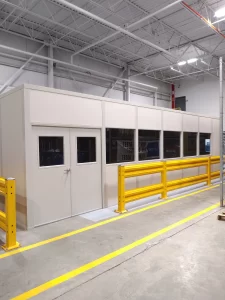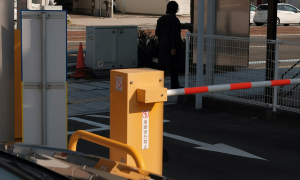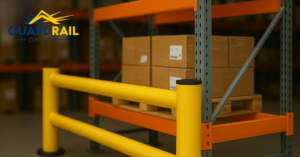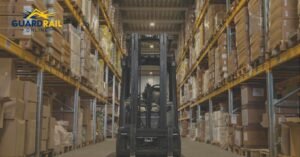Warehouses may seem like well-oiled machines from a distance. Unfortunately, behind the movement of goods, pallets, and forklifts lie several operational hazards that can turn routine tasks into serious incidents. From a crowded loading zone to a narrow passage blocked by misplaced inventory, obstacles in a warehouse pose significant risks. These hazards slow down operations, endanger workers, and compromise warehouse racking safety.
Finding out these potential obstacles within your warehouse are really crucial. They ensure that you take the right actions, like installing warehouse barriers in Arkansas. Assessing of these obstacles also lets you fill any gap in the safety and security within your warehouse. This article aims to help you achieve this. Here we are discussing some of the most serious obstacles that can be a threat to your assets and personnel.
1. Poorly Defined Pedestrian Walkways
Warehouses often treat people paths like an afterthought, painting lines on the floor without physical separation. In the real world, those painted lines fade, get scuffed by forklifts, or become hidden under spilled goods. All this makes the job of forklift operators difficult. This means operators have to constantly scan for pedestrians stepping into their path when foot traffic and forklifts share the same space without clear, lasting borders.
Does that not sound serious enough? Well, did you know that a forklift traveling at just five miles per hour needs over twelve feet to stop? Now imagine if a worker steps off an invisible line and walks right into the forklift lane. In such situations, the operator may not have enough time or sight distance to slow down, turning a simple delivery into a serious collision.
Visitors, inspectors, and temporary staff are most prone to such accidents as they are unfamiliar with your layout. They actually rely on visual markers, but lack of them can create an unsafe space. Moreover, the confusion over where it is safe to walk often leads to hesitations and fear among pedestrians in your warehouse. All this confusion and lack of flow would lead to delays. These slowdowns could backups, forcing drivers to navigate around people in unpredictable ways. When traffic patterns become erratic, near-misses are bound to multiply and the chance of injury climbs.
But all this could be prevented by installing sturdy warehouse barriers in Arkansas. Choosing barriers allows you to transform invisible lines into tangible safety zones. Brightly colored barriers remain highly visible despite wear, guiding both drivers and walkers. This clear separation removes guesswork, enforces consistent traffic flow, and significantly reduces the risk of collisions.
2. Forklift Traffic at Blind Corners
Intersections are far from quiet in most warehouses. Forklifts turn quickly, workers cut across aisles, and inventory carts are pushed from one zone to another. Now add blind corners to the mix. These corners limit visibility, making it almost impossible for forklift operators or workers to anticipate who or what is coming from the other side. When heavy machinery is involved, the margin for error is extremely small.
These moments can lead to head-on collisions, dropped inventory, or worse, serious injury to pedestrians. Let’s not forget the aftermath of such accidents. They would leave you with damaged stock, bent equipment, workflow disruptions, and a spike in maintenance or insurance costs. Over time, these near-misses also create anxiety among team members, impacting morale and concentration.
This is exactly where installing warehouse barriers in Arkansas makes all the difference. Placing brightly colored, high-visibility barriers near blind corners serves two key purposes. First, it slows down approaching vehicles by alerting drivers to hidden intersections. Second, modular warehouse racking safety barriers physically separate cross-traffic, preventing accidental encroachment. Adding corner mirrors or reflectors along with these barriers would further help convert dangerous blind spots into safe, controlled spaces.
3. Inadequate Protection Around Storage Racks
Storage racks are the backbone of any warehouse operation, often holding thousands of pounds of goods stacked over multiple levels. But even with all their strength, they are not immune to impact. A single hit from a forklift, even at low speed, can twist beams, loosen joints, or destabilize the entire rack. This risk only multiplies in warehouses where multiple teams operate across shifts. Rushed maneuvers, tight turns, or poor visibility can all lead to sudden contact.
Such accidents don’t just damage shelving. They put workers at risk of falling items, trigger expensive product losses, and create extended cleanup delays. Even a small collision at the base of a high-bay racking systems can affect load balance several feet above. If one rack leans or collapses, it can drag neighboring systems with it. All this would turn a simple mistake into a widespread disruption. These events at the end of the day not only threaten safety but stall operations and dent bottom-line productivity.
This is why installing warehouse barriers in Arkansas around racking systems is a smart preventive step. Placing sturdy warehouse racking safety barriers along the lower edge of shelving units creates a physical buffer against accidental hits. The safety barriers can absorb the force of the impact and protect the structural integrity of the rack. They will also act as constant visual reminders, helping drivers maintain safer clearance during navigation.
4. Overflow in Staging and Sorting Areas
Staging zones are spaces where goods are temporarily placed before being loaded, sorted, or moved to storage. An ideal staging area is supposed to act as controlled zones. But in the real world, delays in outbound shipments or an unexpected delivery surge can throw that control off balance. Delays can lead to pallets stacking up beyond the marked zone. Cartons on the other hand may end up lining the walkways. With less space available, the equipment may begin to be parked in rush around any empty space. Soon enough, staging areas turn into choke points that restrict movement and increase collision risks.
The consequences of such chaos are more than just inconvenience. Cluttered staging zones would confuse routing for forklifts, forcing operators to navigate around unplanned obstacles. That increases the chance of sideswipes, dropped loads, or tripping hazards. Workers may even trip over stray packaging, and forklifts might roll into unsecured items, causing damage or delays. These chain reactions would slow down order processing, reduce worker efficiency, and compromise safety for everyone moving through the area.
This is where warehouse barriers in Arkansas offer a structured solution. A few sellers offer warehouse barriers in Arkansas that can be installed in quick time and can be removed when needed. You can use such flexible safety barriers or sturdy rails around designated staging zones. They would create a physical buffer, preventing overflow from spilling into surrounding lanes. Such barriers would clearly signal boundaries to workers and drivers alike, promoting smarter organization and movement.
5. Pinch Points and Mechanical Hazards
Warehouses that rely on automation often come with built-in risks—none more dangerous than pinch points. These are areas where moving parts close in on each other, such as conveyor ends, machine joints, or the edges of powered lifts. A single lapse in attention can result in crushed fingers, caught sleeves, or worse. It’s a daily reality in many facilities. Even seasoned workers, who know the layout well, face moments of risk when pace quickens or focus shifts.
These mechanical hazards don’t just affect safety; they create a mental load. Teams move cautiously near conveyors or robotic arms, which can lead to slower workflows or inconsistent movement patterns. Additionally, despite safety briefings or floor warnings, it’s easy for someone unfamiliar with the space like a temporary worker or vendor to step too close.
This is why installing warehouse barriers in Arkansas around mechanical pinch zones is essential. Guardrails act as strong, visual dividers that keep people at a safe distance without disrupting the flow of materials. They also help maintain OSHA compliance by ensuring physical safeguards exist where floor markings alone fall short. With barriers in place, your team gains freedom to move with confidence, knowing that risk-heavy zones are kept securely out of reach.
6. Unmarked or Unsecured Restricted Zones
Warehouses aren’t just made up of storage racks and traffic lanes. They also include restricted zones. These areas may contain hazardous materials, high-voltage panels, sensitive inventory, or processes that require controlled access. Yet in many facilities, these zones blend into the background. A lack of physical separation or proper signage makes it easy for employees, contractors, or new hires to unknowingly enter places they shouldn’t be.
The danger here isn’t always immediate, but the consequences are serious. Unauthorized entry can lead to exposure to confidential stock, tampering with sensitive assets, or interruptions in ongoing operations. Relying solely on painted lines or verbal instruction often proves ineffective especially when it comes to new workers or third-party personnel unfamiliar with your layout. Without visible, unmistakable boundaries, even routine foot traffic can drift into high-risk or private zones.
This is where warehouse barriers in Arkansas offer a practical and powerful solution. You can create a physical reminder that entry is limited by framing restricted zones with brightly colored barriers or controlled entry points. Swing gates or removable rail panels can also be added to allow authorized access when needed. These fixed boundaries reduce confusion, enforce compliance, and elevate the overall warehouse barriers safety standard.
7. Falling Objects and Racking Collisions
In many warehouses, pallet racks extend upwards of twenty feet, stacked with heavy inventory that shifts with every movement below. But the higher you store, the greater the risk it poses. One small collision, perhaps from a forklift misjudging clearance, can send boxes crashing down. At that height, even lightweight packages gain enough momentum to cause serious injury. Worse still, a hard-enough impact can weaken a racking frame, turning a minor bump into a structural hazard.
These situations don’t just threaten safety, but derail productivity too. Damaged goods must be sorted or replaced. Sections of the warehouse might be cordoned off. The aftershock ripples through schedules, costs, and team morale. Workers may even begin to second-guess their routes, while supervisors end up pulled into reactive firefighting mode.
Warehouse racking safety barriers become non-negotiable to minimize these risks. Warehouse barriers in Arkansas placed at the base of pallet racks catch slipping goods before they enter aisles. Some operations also install mesh panels behind racks to stop backward spills. These simple additions reinforce warehouse barriers safety standards, making walkways more secure and racks more resilient.
Conclusion
No warehouse operates without obstacles. Challenges are part of daily operations, whether it’s space constraints, unpredictable traffic, or evolving workflows. However, the primary approach to minimizing their adverse effects lies in foresight. Facilities that actively plan for disruptions rather than simply react to them consistently perform safer, faster, and more efficiently.
That’s where strategic tools come into play. Warehouse barriers in Arkansas are not just physical structures; they represent smart, long-term planning. They help define zones, direct movement, and prevent risks before they escalate into costly problems. Their value goes beyond compliance or control. They actively shape a safer, more streamlined work environment.
By integrating strong and robust warehouse barriers in Arkansas into your layout you are not just solving today’s issues. You are actually setting up a system that adjusts with your operations, protects your team, and reinforces discipline across the floor.
So, why not install safety barriers in your warehouse today? Contact Guardrail Online for the best quality safety barriers today!





